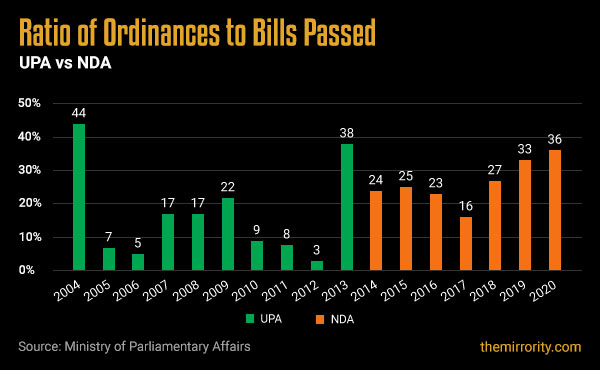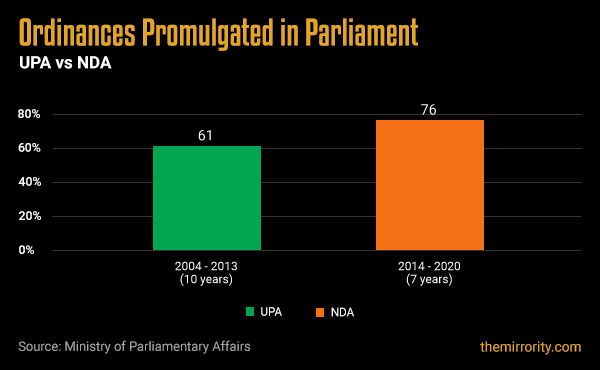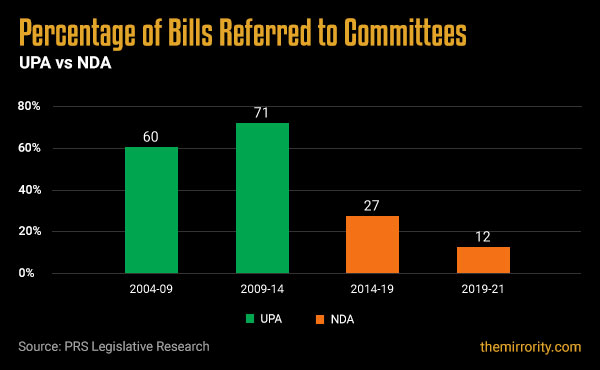
Image Source: PTI
India has for long prided itself as a shining example of parliamentary democracy, one in which the citizens elect their representatives to make the necessary laws and decisions on their behalf. The legislative branch of the government includes the Council of Ministers, with the Prime Minister as its head, aid, and advice the President who is the constitutional head of the country. This contrasts with a presidential form of democracy where its leader is called a President who is elected by the citizens to lead a branch of government separate from the legislative branch. The USA is an example of such a democracy.
In a parliamentary democracy, it thus becomes binding on the elected representatives to discuss and debate on bills (legislative proposals) to accommodate the views of the majority before they are enacted into laws. This function of participative discussions and debates is increasingly getting sidestepped in favor of unilateral decision making by the government that holds the majority in the House using Ordinances and bypassing parliamentary committees.
Ordinance
An ordinance is a temporary law made when Parliament is not in session that enables the Central government to take immediate legislative action in cases of national importance. An ordinance becomes law on being approved by Parliament within six weeks of reassembly. The ordinance route allows the parliamentary debates to be bypassed and hence is not the preferred process for enacting legislative changes.
Besides India, there are only two other parliamentary democracies in the world that permit the ordinance route - Pakistan and Bangladesh. In every other country, the Parliament must be convened to get a law passed.

The ratio of ordinances to bills passed by the Parliament has been increasing steadily. In the last 2 years alone (2019-2020), over one-third of bills were not discussed between the members of the Lower House (Lok Sabha) or the Upper House (Rajya Sabha).

The BJP-led NDA government has a clear preference for bypassing any discussions in the Parliament. The Congress-led UPA government passed 61 ordinances in their 10-year tenure while the BJP-led government exceeded that count and has passed 76 ordinances in only 7 years. Some of the recent and controversial ordinances:
- Demonetisation: The Specified Bank Notes (Cessation of Liabilities) Ordinance, 2016 was issued on 28 December 2016, ending the liability of the government for the demonetised banknotes. The demonetisation exercise took out 85% of India’s banknotes from circulation with 4 hours’ notice and caused immeasurable personal and financial suffering to Indian citizens, some of which is felt until today. The exercise was deemed a failure as 99.3% of all demonetised banknotes were again deposited with the banks thereby busting the myth of trapping ₹4-5 trillion of black money. Read more about demonetisation here.
- New Farm Laws: The Centre promulgated three ordinances in the first week of June 2020 that meant to change the way India's farmers do business and sparked one of India's biggest protests and a nearly year-long standoff with the government. Read more about it here.
- Extension of CBI and ED Chief’s Tenure: On 14 November 2021, the BJP government at the Centre brought two ordinances to extend the tenures of the Chiefs of the Central Bureau of Investigation (CBI) and Enforcement Directorate (ED) in direct violation of the Supreme Court orders. This further compromised the autonomy of the investigative agencies and made their Chiefs even more amenable to following the directives of the Central government. Read more about it here.
This ordinance culture is no longer limited to the Centre and is getting extended to BJP-run states as well. On 15 March 2020, the BJP government in Uttar Pradesh promulgated the Uttar Pradesh Recovery of Damages to Public and Private Property Ordinance to impose punitive fines on those who damaged public and private properties during protests. During the Covid-19 lockdown period, BJP governments in Uttar Pradesh, Madhya Pradesh, and Gujarat issued ordinances diluting labor laws, without consulting worker unions and civil rights groups which was even cautioned by the International Labour Organisation.
Parliamentary Committees
Given the volume or complexity of the bills, it is not always possible for the MPs to thoroughly analyze any legislation. Some legislations require expert domain expertise to incorporate specific nuances to ensure its complete efficacy. As of now, 24 Parliamentary Committees are dealing with a different subject matter. These committees, with MPs representing different parties, study the bills, seek inputs from external stakeholders and the public, and make recommendations that are non-binding on the Parliament. The Companies Bill, 2009, is an excellent example of legislation that was improvised due to the issues highlighted by the committee.
Countries such as Sweden and Finland mandate all bills to be sent to committees. In Australia, there is a selection of bills committee, which is specifically tasked with identifying the bills that should go to committees. In the Indian parliamentary setup, it is not mandatory for bills to be sent to committees and is left to the discretion of the Chair - the Speaker in the Lok Sabha and Chairperson in the Rajya Sabha.

As the above graph denotes, the BJP-led NDA government does not believe much in consulting the Parliamentary Committees. Only 12% of the bills passed between 2019-21 were run past any parliamentary committee in comparison to over 60% of the bills passed during the UPA regime which engaged expert committees to consult and guide them in framing the legislation. Since BJP has a brute majority in the Lok Sabha, it has been able to get away without consulting any committees for its legislations, some of which have turned out to be extremely controversial and challenged by public policy experts.
Despite being a parliamentary democracy, our legislative setup is beginning to look and behave more autocratic in nature. If 543 elected representatives are not able to trust each other and function as a cohesive set-up, hoping 1.3 billion Indians to live in harmony only seems like chasing rainbows.
Democracy is the art of thinking independently together - Alexander Meiklejohn.
TO READ THE FULL ARTICLE

Get full access to the exciting content on The Mirrority by logging in
Support independent journalism
Even the very best of media houses in our country today are yielding to the pressure of click-bait journalism in order to survive. More than ever before, our country needs journalism that is independent, fair and non-pliant to the bureaucracy. Such journalism needs the support of like-minded readers like you to help us survive editorially and financially.
Whether you live in India or India lives inside you, help us continue to produce quality journalism with your contribution.
CONTRIBUTE
